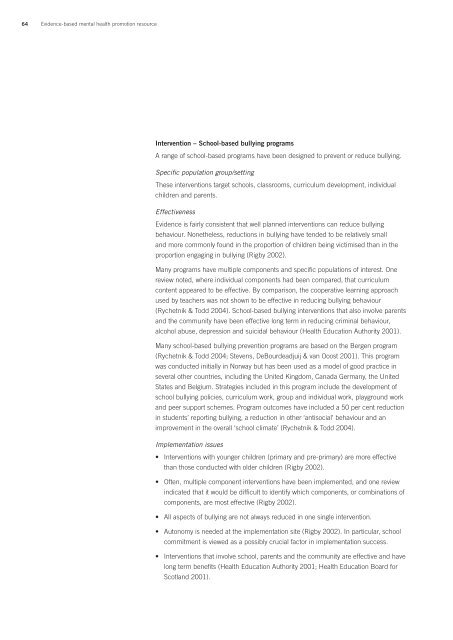Evidence-based mental health promotion resource - health.vic.gov.au
Evidence-based mental health promotion resource - health.vic.gov.au
Evidence-based mental health promotion resource - health.vic.gov.au
You also want an ePaper? Increase the reach of your titles
YUMPU automatically turns print PDFs into web optimized ePapers that Google loves.
64 <strong>Evidence</strong>-<strong>based</strong> <strong>mental</strong> <strong>health</strong> <strong>promotion</strong> <strong>resource</strong>Intervention – School-<strong>based</strong> bullying programsA range of school-<strong>based</strong> programs have been designed to prevent or reduce bullying.Specific population group/settingThese interventions target schools, classrooms, curriculum development, individualchildren and parents.Effectiveness<strong>Evidence</strong> is fairly consistent that well planned interventions can reduce bullyingbehaviour. Nonetheless, reductions in bullying have tended to be relatively smalland more commonly found in the proportion of children being <strong>vic</strong>timised than in theproportion engaging in bullying (Rigby 2002).Many programs have multiple components and specific populations of interest. Onereview noted, where individual components had been compared, that curriculumcontent appeared to be effective. By comparison, the cooperative learning approachused by teachers was not shown to be effective in reducing bullying behaviour(Rychetnik & Todd 2004). School-<strong>based</strong> bullying interventions that also involve parentsand the community have been effective long term in reducing criminal behaviour,alcohol abuse, depression and suicidal behaviour (Health Education Authority 2001).Many school-<strong>based</strong> bullying prevention programs are <strong>based</strong> on the Bergen program(Rychetnik & Todd 2004; Stevens, DeBourdeadjuij & van Ooost 2001). This programwas conducted initially in Norway but has been used as a model of good practice inseveral other countries, including the United Kingdom, Canada Germany, the UnitedStates and Belgium. Strategies included in this program include the development ofschool bullying policies, curriculum work, group and individual work, playground workand peer support schemes. Program outcomes have included a 50 per cent reductionin students’ reporting bullying, a reduction in other ‘antisocial’ behaviour and animprovement in the overall ‘school climate’ (Rychetnik & Todd 2004).Implementation issues• Interventions with younger children (primary and pre-primary) are more effectivethan those conducted with older children (Rigby 2002).• Often, multiple component interventions have been implemented, and one reviewindicated that it would be difficult to identify which components, or combinations ofcomponents, are most effective (Rigby 2002).• All aspects of bullying are not always reduced in one single intervention.• Autonomy is needed at the implementation site (Rigby 2002). In particular, schoolcommitment is viewed as a possibly crucial factor in implementation success.• Interventions that involve school, parents and the community are effective and havelong term benefits (Health Education Authority 2001; Health Education Board forScotland 2001).



